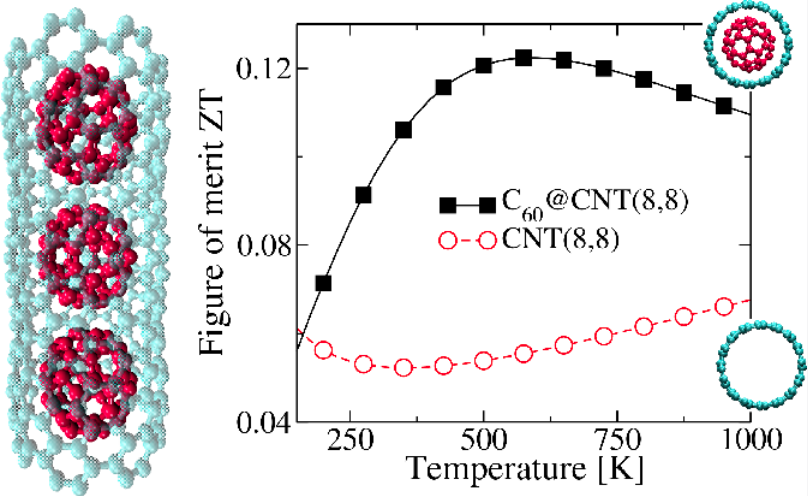

Gaining control over heat flow at the nanoscale poses a major challenge to current experimental techniques. The issue here is not only the reduction of heat dissipation in nanoelectronic devices or the blocking of thermal transport to increase the thermoelectric efficiency but also to engineer thermal devices to exploit the richness of nanoscale material properties. Thus, analogs of electronic devices, such as thermal rectifiers, thermal transistors, and thermal logic gates, have already been theoretically proposed and in a few cases experimentally demonstrated. Here, atomistic design strategies for smart nanodevices and nanomaterials are required, in particular the combination of computationally efficient atomistic methodologies with quantum transport based approaches.
In this presentation, I will address two topics: (i) Electron and phonon transport in CNT peapods with the aim of elucidating their potential advantage over pristine CNTs as basic thermoelectric elements. I will show that the electron and phonon transport properties are sensitively modified by C60 encapsulation, when the CNT–C60 intermolecular interaction is strong enough to produce a periodic buckling of the CNT walls. In general, a larger TE figure of merit is obtained over a broad temperature range for the CNT peapod when compared with the pristine CNT, achieving an increase by a factor of 2.2 at 575 K. (ii) I will introduce a nanoscale phononic analog of the Ranque-Hilsch vortex tube in which heat flowing at a given temperature is split into two different streams going to the two ends of the device, inducing a temperature asymmetry. The nanoscale prototype consists of two carbon nanotubes (capped and open) connected by molecular chains. Our results show that the structural asymmetry in the contact regions is the key factor for producing the flux asymmetry and, hence, the induced temperature-bias effect. This study yields insights into the thermal management in nanoscale materials, especially the crucial issue of whether the thermal asymmetry can survive phonon scattering over relatively long distances, and thus provides a starting point for the design of a nanoscale phononic analog of the Ranque-Hilsch vortex tube.


Gaining control over heat flow at the nanoscale poses a major challenge to current experimental techniques. The issue here is not only the reduction of heat dissipation in nanoelectronic devices or the blocking of thermal transport to increase the thermoelectric efficiency but also to engineer thermal devices to exploit the richness of nanoscale material properties. Thus, analogs of electronic devices, such as thermal rectifiers, thermal transistors, and thermal logic gates, have already been theoretically proposed and in a few cases experimentally demonstrated. Here, atomistic design strategies for smart nanodevices and nanomaterials are required, in particular the combination of computationally efficient atomistic methodologies with quantum transport based approaches.
In this presentation, I will address two topics: (i) Electron and phonon transport in CNT peapods with the aim of elucidating their potential advantage over pristine CNTs as basic thermoelectric elements. I will show that the electron and phonon transport properties are sensitively modified by C60 encapsulation, when the CNT–C60 intermolecular interaction is strong enough to produce a periodic buckling of the CNT walls. In general, a larger TE figure of merit is obtained over a broad temperature range for the CNT peapod when compared with the pristine CNT, achieving an increase by a factor of 2.2 at 575 K. (ii) I will introduce a nanoscale phononic analog of the Ranque-Hilsch vortex tube in which heat flowing at a given temperature is split into two different streams going to the two ends of the device, inducing a temperature asymmetry. The nanoscale prototype consists of two carbon nanotubes (capped and open) connected by molecular chains. Our results show that the structural asymmetry in the contact regions is the key factor for producing the flux asymmetry and, hence, the induced temperature-bias effect. This study yields insights into the thermal management in nanoscale materials, especially the crucial issue of whether the thermal asymmetry can survive phonon scattering over relatively long distances, and thus provides a starting point for the design of a nanoscale phononic analog of the Ranque-Hilsch vortex tube.